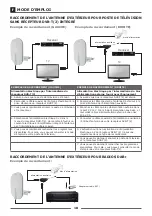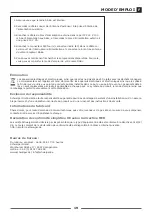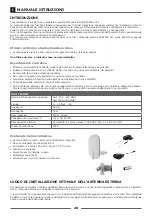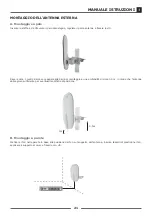
USER GUIDE
8
INTRODUCTION
Congratulations and thank you for purchasing this DTA4000 011 outdoor aerial.
This user guide is designed to help you use and operate the device. Read through the User guide carefully. Store this
manual safely throughout the product‘s entire service life and pass it on to any subsequent users or owners.
Check that the supplied package is complete and ensure that none of the parts are defective or damaged.
All devices that we distribute comply with the safety regulations valid at the time of purchase, and are safe provided they
are used for the intended purpose.
For simplicity, the DTA4000 011 outdoor aerial is referred to as „outdoor aerial“ in this guide.
How to use this aerial
• The outdoor aerial is used to receive digital television and radio programmes.
It must not be used for any other purpose!
Safety instructions
• Please use a suitable plug-in power supply unit (see Technical Data). Make sure the polarity is correct.
• This outdoor aerial is an electronic product that must be kept away from children!
• Therefore, keep it out of the reach of children.
• Do not introduce any objects into the product’s connections or openings.
• Have the outdoor aerial repaired by a technician if it is defective.
• Disconnect the power plug before cleaning.
• Clean this outdoor aerial only using a lint-free, damp cloth that is as light as possible and do not use any aggressive
cleaning agents. In doing this, especially ensure that no water (no fluid or moisture) gets into the product.
TECHNICAL DATA
Frequency -/ Reception range
VHF (174 - 230 MHz)
UHF (470 -790 MHz)
Channels
5 – 12 & 21 – 60
Gain
36 dB
Impedance
75 Ω
Coaxial cable
8,5 m included
Receiver/TV connection
5-6 V DC 50 mA
Electrical connection
Plug-in power supply included, 100-240 V AC / 12 V DC 100 mA
Protection rating
IPX4
Package content
• Active outdoor aerial (UHF / VHF) with integrated amplifier
• Coaxial connecting cable 8.5 m
• Plug-in power supply 100-240 V AC / 12 V DC 100 mA
• Power inserter
• Mast installation
• Radio (IEC) adapter
• User guide with Safety instructions
OPTIMUM LOCATION FOR THE OUTDOOR AERIAL
You should ensure that there are as few obstacles as possible which may block the signal between the transmitter and
the outdoor aerial to guarantee optimum reception.
DVB-T(2) receivers often have a signal strength indicator. This indicator will help you find the best aerial position. Check
different positions and signal directions before you finally site the aerial.









































